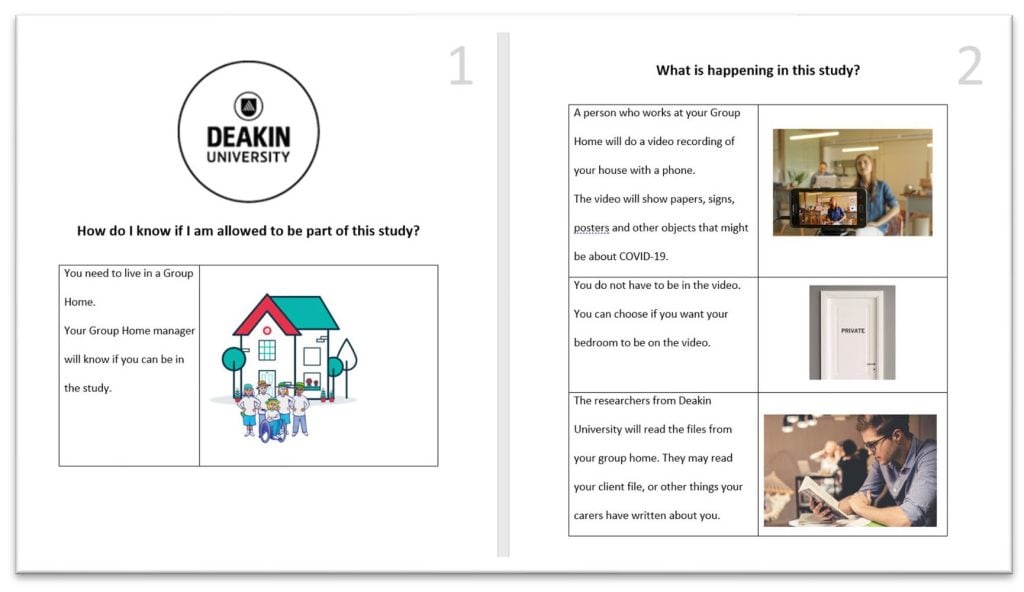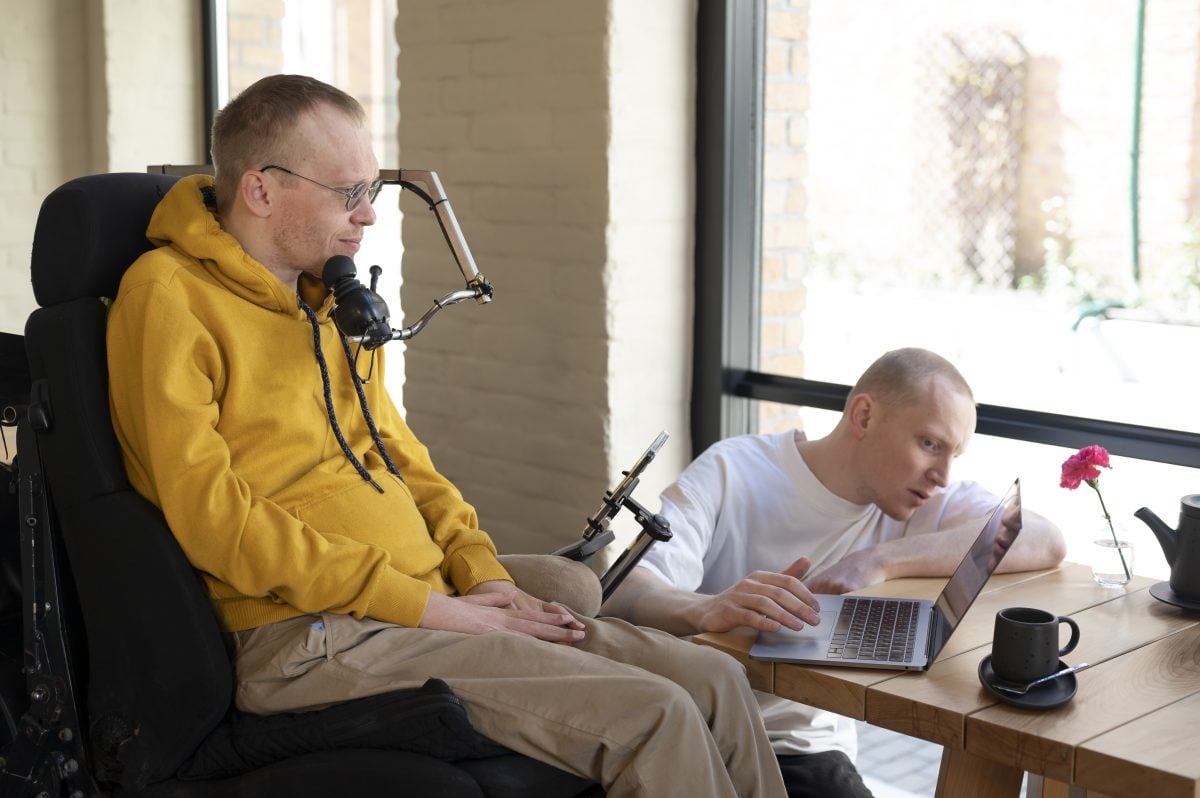Doing Inclusive Research
Kate Anderson and Jo Watson
Over the years, we have adapted our research materials to make our projects more inclusive and accessible. We have shared some of these here, along with an explanation of how and why they have been used. You are welcome to adapt these resource ideas for your own work.
Participant Choice
No research method is the perfect fit for all participants. When working with diverse communities, we have found it valuable to provide people with a choice in how they want to participate. For example:
- Choosing to participate individually or in a group
- Choosing how they would like to communicate their perspectives, for example through spoken or Auslan (signed) interactions, written submissions, creating photographs or drawings, or using augmentative and alternative communication (AAC) tools.
- Choosing if they want to participate in further or continued research.
An online interface that we have used for this process can be viewed in more detail in this post from Dion Williams.
Adapted Consent
It is important that research participants understand the study before they agree to participate. This is called giving informed consent. In most studies, participants will be given a written Plain Language Statement (containing information about what the study will involve), and a consent form to sign. This approach can be problematic for several reasons:
- Accessibility: Printed consent forms can be difficult for people with vision impairment to read.
- Convenience: Signing a consent form as a printed or electronic document can involve a number of steps (e.g., printing, signing, scanning, uploading or posting a document)
- Literacy and Language: Technical words or complex language used by researchers can be confusing for research participants. Written information statements and consent forms can also be a barrier for people with limited English proficiency, or those with low literacy skills. Approximately 40% of Australians have literacy abilities below the level needed to participate comfortably in work, education and society.
- Importance: When we have tested standard information and consent forms with some research participants, they have told us that not all of the information is important to them. Participants may skim or ignore lengthy research documents, and can easily miss the information that’s most important.
There are several ways that we have adapted our consent process for participants. One strategy is to use very simple language combined with meaningful pictures, as shown in the screenshot below. This format is easier for people with lower literacy or language skills to understand. It can also be useful when a participant and a researcher/supporter are having a less formal conversation about the study.

Another strategy we have developed with the support from our Advisory Groups is video information statements. These were first suggested to us by our industry co-researchers at Northcott and Able Australia, in our project on inclusive health communication in disability group homes. You can see lots of examples on our project site, e.g., for support worker interviews and group home case studies. We usually record our videos using Microsoft PowerPoint. They are a combination of simple spoken language, simple text, and pictures. We sometimes add captions or sign language, depending on the audience. Our video process was first designed for participants with intellectual disability who were unable to read, and for disability support workers who were very busy or did not have strong English language skills. However, we have found the videos to be very helpful for many other studies. They are easy to access on a mobile device, quick to watch, easier to understand, and they can also be very reassuring. We strongly recommend the approach!
Online survey platforms can also be used for participant consent. Online paperwork is more convenient for many people, as it does not require printing, signing or returning a physical document. There are many considerations for accessibility if you are using this approach, including:
- Ensuring adequate visual accessibility (font size, contrasts and backgrounds).
- Ensuring digital accessibility (can everything in the survey be read and accessed using a screen reader, or an alternative to a keyboard or mouse? For example, providing an alternative to on-screen signatures for those who cannot use a finger or stylus to sign)
- Enabling any “read-aloud” features that are provided by the system.
- Integrating meaningful pictures or symbols where this can support understanding.
You can learn about our approach to online consent in the My Active Life study in this detailed protocol by Dion Williams.
Finally, we use Supported Decision Making as a way to involve people with very significant communication disability or diversity in the consent process. This is often used for participants with severe-profound intellectual disability, late-stage dementia, significant psychosocial disability, and with very young children. Supported decision making is defined by Watson (2016) as an interdependent and continuous process shared between the participant and supporters who know them well. The person facing the decision contributes by expressing their will and preference through a range of means including facial expression, body language, gesture, physiological reactions and behaviour. Supporters’ contribution to the process is to respond to these expressions of will and preference, by acknowledging, interpreting and acting on these expressions. Importantly, accessible information and consent materials are still provided as appropriate to the person’s communication support needs, to ensure they have the best possible understanding of the research.
“Proxy consent” is a common strategy used in research with these groups of people, but it often refers to a legal guardian who gives consent on behalf of someone else. For example, a parent might sign a consent form for their child to participate in research, without the child providing consent. The use of a proxy/supporter is different in Supported Decision Making. A proxy/supporter must:
- Have a positive and stable relationship with the participant, or are willing/able to develop such a relationship;
- Know the focus person’s history or are willing to learn about it;
- Have a commitment to the person’s duty of care;
- Be familiar with the focus person’s communication and therefore their expressions of preference;
- Be committed to prioritising the perspective of the focus person;
- Be committed to the principle of Assent: this means that any consents obtained by proxy are required to be accompanied by nonverbal indications that the person is comfortable participating in the study, and any indication at any time over the course of the study of refusal to participate must be respected.
Supported Decision-Making provides an opportunity for people with significant communication or cognitive disability (a group traditionally excluded from research) to contribute to research that will improve their lives. For further information about this technique and how you could use it in your own work, you can contact [email protected].
Accessible Surveys
We have developed a number of accessible online surveys for quantitative research, including demographic data collection, Quality of Life evaluations, Resource Use Measures, activity and intervention diaries, and service user feedback. We are in the process of making some of these available as templates via the REDCap survey archive. You can also download our templates for Qualtrics via these links, which will be updated as we develop new materials.
Qualtrics Template – Accessible_Survey_Template (please email us for a file that can be directly imported into Qualtrics)
REDCap: please email our team for importable templates.
We will continue to develop this page as we develop new approaches and resources. Please feel free to contact [email protected] if you would like to see a specific topic addressed.
